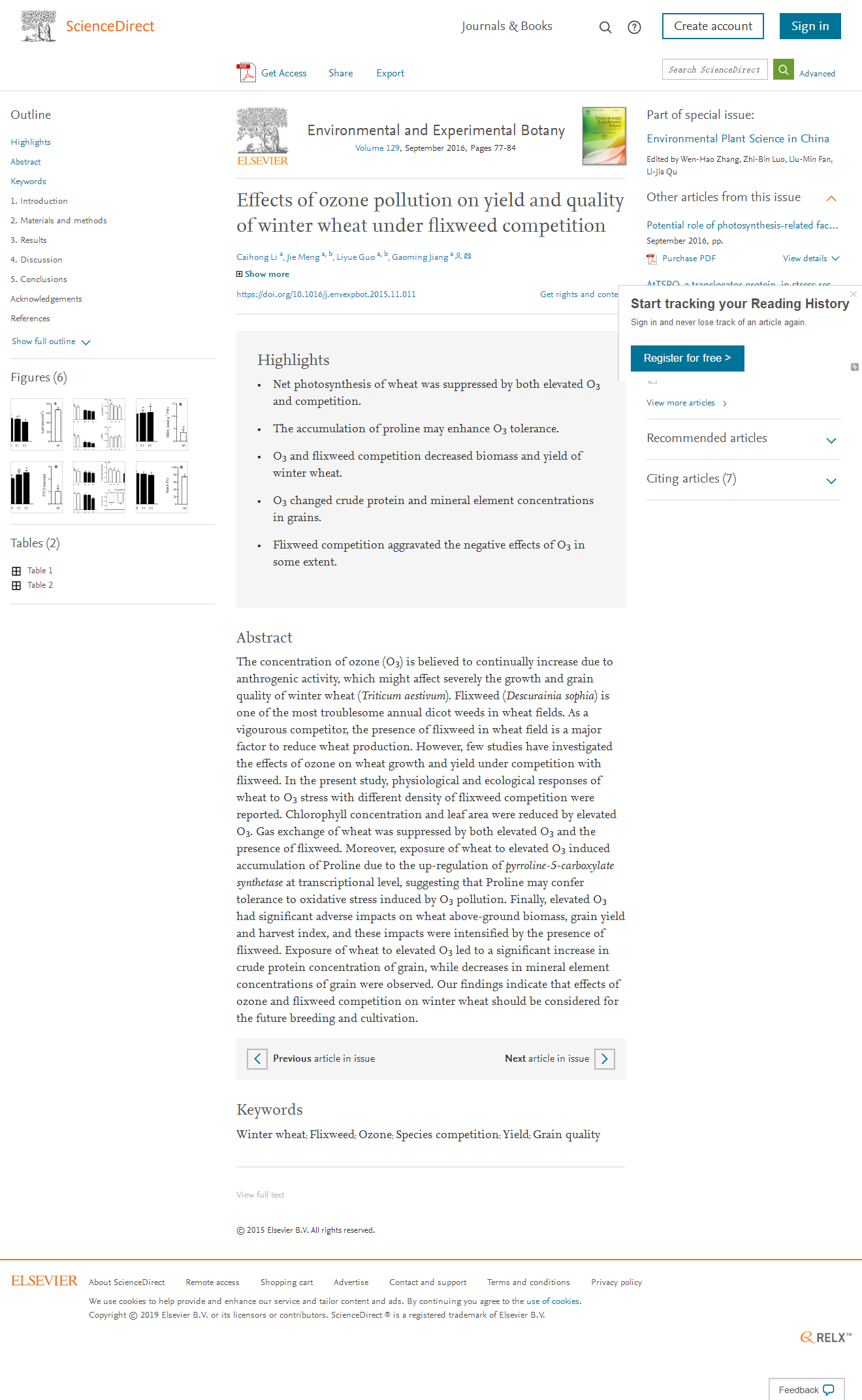博文
播娘蒿竞争下臭氧污染对冬小麦产量和品质的影响
|||
播娘蒿竞争下臭氧污染对冬小麦产量和品质的影响
李彩虹 孟杰 郭立月 蒋高明*
*通讯作者
中国科学院植物研究所植被与环境变化国家重点实验室,北京香山南辛村20号 100093
中国科学院大学资源与环境学院,北京玉泉路19号,100049
环境与实验植物学报,2016, 129: 77–84(影响因子:5.345)
主要发现:小麦净光合速率受到高浓度O3和播娘蒿竞争的双重抑制;脯氨酸积累可增强对O3的耐受性;O3和播娘蒿竞争降低了冬小麦生物量和产量;O3改变了籽粒中粗蛋白和矿质元素含量;播娘蒿竞争加剧了O3对小麦生长抑制作用。
摘要:由于人为活动影响大气中的臭氧(O3)浓度而不断增加,严重影响了冬小麦(Triticum aestivum)生长发育和籽粒品质。播娘蒿(Descurainia sophia)是麦田最为棘手的一年生双子叶杂草之一。作为一个强有力的竞争对手,小麦播娘蒿的存在是影响小麦产量的主要因素。在播娘蒿竞争的条件下,很少有人研究臭氧对小麦生长和产量的影响。本文报道了不同密度播娘蒿竞争条件下,小麦对O3胁迫的生理生态响应。研究发现,高浓度O3降低了叶绿素浓度和叶面积。高浓度O3和播娘蒿都抑制了小麦的气体交换。此外,由于在转录水平上吡咯啉-5-羧酸合成酶的上调,小麦在O3升高下表现为脯氨酸累积,表明脯氨酸可能赋予O3污染引起的一定的氧化应激耐受性。高浓度O3对小麦地上生物量、产量和收获指数都有显著的不利影响,而播娘蒿的存在加剧了这些影响。高浓度O3使小麦籽粒粗蛋白含量显著增加,矿质元素含量降低。我们的研究结果表明,在今后的育种和栽培中,应考虑臭氧污染下播娘蒿竞争对冬小麦的影响。
关键词:冬小麦;播娘蒿;臭氧;种间竞争;产量;品质
Effects of ozone pollution on yield and quality of winter wheat under flixweed competition
Caihong Li, Jie Meng, Liyue Guo, Gaoming Jiang*
State Key Laboratory of vegetation and environmental change, Institute of Botany, Chinese Academy of Sciences, No. 20, Nanxin village, Xiangshan, Beijing 100093
School of Resources and Environment, Chinese Academy of Sciences, 19 Yuquan Road, Beijing, 100049
Environmental and Experimental Botany, 2016, 129: 77–84(IF=5.345)
Highlights:Net photosynthesis of wheat was suppressed by both elevated O3 and competition;The accumulation of proline may enhance O3 tolerance;O3 and flixweed competition decreased biomass and yield of winter wheat;O3 changed crude protein and mineral element concentrations in grains;Flixweed competition aggravated the negative effects of O3 in some extent.
Abstract:The concentration of ozone (O3) is believed to continually increase due to anthrogenic activity, which might affect severely the growth and grain quality of winter wheat (Triticum aestivum). Flixweed (Descurainia sophia) is one of the most troublesome annual dicot weeds in wheat fields. As a vigourous competitor, the presence of flixweed in wheat field is a major factor to reduce wheat production. However, few studies have investigated the effects of ozone on wheat growth and yield under competition with flixweed. In the present study, physiological and ecological responses of wheat to O3 stress with different density of flixweed competition were reported. Chlorophyll concentration and leaf area were reduced by elevated O3. Gas exchange of wheat was suppressed by both elevated O3 and the presence of flixweed. Moreover, exposure of wheat to elevated O3 induced accumulation of Proline due to the up-regulation of pyrroline-5-carboxylate synthetase at transcriptional level, suggesting that Proline may confer tolerance to oxidative stress induced by O3 pollution. Finally, elevated O3 had significant adverse impacts on wheat above-ground biomass, grain yield and harvest index, and these impacts were intensified by the presence of flixweed. Exposure of wheat to elevated O3 led to a significant increase in crude protein concentration of grain, while decreases in mineral element concentrations of grain were observed. Our findings indicate that effects of ozone and flixweed competition on winter wheat should be considered for the future breeding and cultivation.
Keywords: Winter wheat;Flixweed;Ozone;Species competition;Yield;Grain quality

https://blog.sciencenet.cn/blog-475-1206315.html
上一篇:臭氧诱导的冬小麦品种抗旱可塑性种间差异研究
下一篇:不同耕作与施肥方式对有机玉米田杂草群落和作物产量的影响